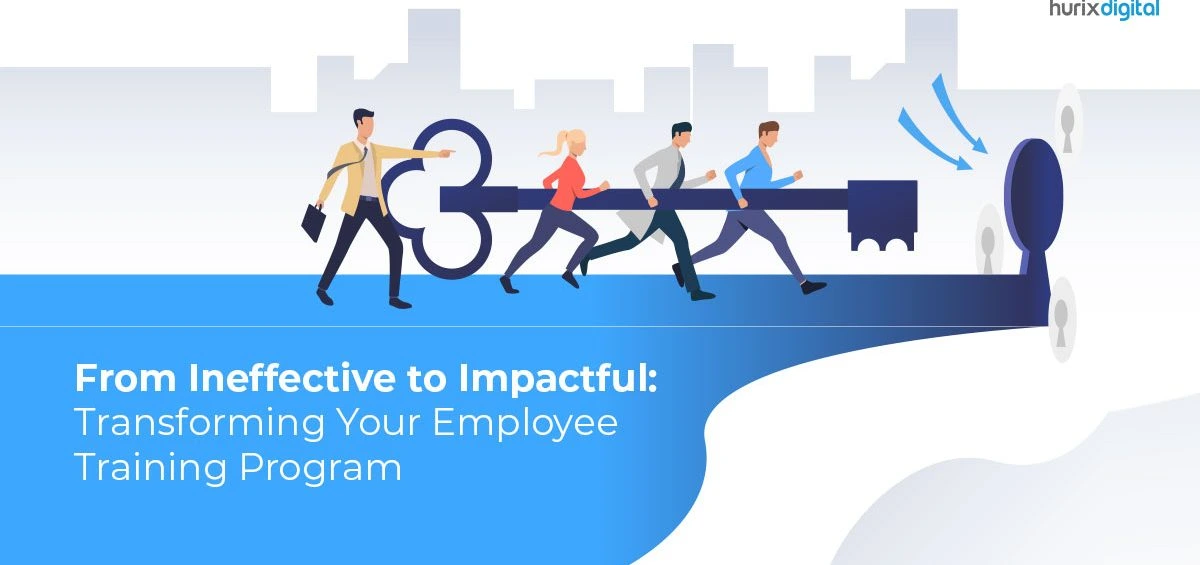Powered by developing and training staff, learning and development (L&D) teams lead the way to greater long-term business growth and success. While it is challenging to keep staff motivated for productive results, the innovations and advancements in technology have helped usher in more immersive learning with tech like augmented reality (AR).
As per a recent survey, immersive and collaborative tech like AR/MR/VR emerged among the top 3 L&D trending training formats in 2022.
Being a cost-effective approach to training, AR in L&D brings on several benefits to company efficiency and success. It provides technologically enhanced interactive learning experiences, which help increase knowledge retention rates and improve learning outcomes.
In this article, we’ll discuss why implementing AR in corporate learning and training is invaluable for organizations. Before we dig deeper, let’s begin by defining AR.
Table of Contents:
- What is Augmented Reality?
- When io Use AR Technology for Training and Development?
- Impact of AR Training Solutions on L&D
- Wrapping Up
What is Augmented Reality?
Unlike virtual reality, which creates a total change in surroundings, AR is the digital augmentation of the real world, which blends the real-life environment with digital content and features. Simply put, AR technology lets you add a virtual overlay to your physical or current surroundings.
Hardware required for AR is easily available in the market. The basic tools used are accelerometers, cameras, solid-state compasses, and GPS. With display sensors, input devices, and a processor, most smartphones have everything required for AR.
The key features of AR in L&D:
- Utility in real-time interaction
- Blurring the division between the digital and real worlds
- Three-dimensional (3D) registration of the virtual objects and the event organically
When io Use AR Technology for Training and Development?
- Application: To build performance assistance, job aids, or learning-to-support systems.
- Interactivity: The convergence of the virtual and real world helps the employee to learn beyond real-life devices.
- Practice: When employees must only be moderately immersed.
- Effect: Improved performance and productive outcomes.
- Tools: Magic Leap One/HoloLens, Smart Glasses, etc.
- Auditory & Haptic Involvement: When multi-media is enough for learning simulation.
Impact of AR Training Solutions on L&D
By opening doors to endless possibilities, AR-based onboarding programs, and training formats have taken the L&D industry by storm.
According to the latest data, mobile AR user devices are expected to reach 1.7 billion by 2024, a growth of 1.5 billion since 2015. AR is undoubtedly the most retentive, engaging, and innovative training solution to achieve greater learning outcomes.
Also Read: Streamline Your Corporate Training with the Best E-Learning Platforms
Here’s how augmented reality in learning and development can enhance corporate training:
1. Increased Engagement and Better Performance
For effective learning, it is crucial to capture and hold learners’ attention during training. Learners are more likely to drop out of a course when they find their training material to be boring or unexciting. Here’s when AR proves to be the most effective solution.
AR in L&D can help engage larger audiences simultaneously and make them more thrilled to learn and share their experience with peers. Practice is the key to staff success. But employees usually lack real-world practice opportunities due to the risk of committing mistakes that can lead to serious circumstances.
AR allows employees to use digital functions for practicing without worrying about real-world consequences. It also supports increased performance by providing instruction throughout the learning process.
With the incorporation of virtual maps, office signs, and AR cards, AR applications in employee learning relay all information, tools, and instruction to the user’s viewpoint.
2. Personalized and Social Learning Experience
AR allows participants to tweak their learning environment, learn how they want to, explore the possibilities, and learn from individual consequences, offering each employee a personalized learning experience.
For instance, AR training is a great way to onboard new candidates as it provides excellent guidance, indulges them in a collaborative environment, and connects them to the company’s mission.
When it comes to the application of immersive technologies in L&D, AR training has the upper hand over other emerging tech like VR or MR. Virtual Reality (VR) users put on a headset, and they can’t see, hear or interact with other people.
AR, on the contrary, promotes social learning. It is a learning methodology in which participants learn from each other through imitation, modeling, and observation. This ensures that all employees share the same learning experience.
3. Knowledge Retention and Point-of-Need Learning
What does it take to make a successful L&D program? The key is to have the right combination of hands-on activities like engaging tasks, interaction, and supervision. AR helps with just that. It incorporates all of these elements into the training experience, helping employees to retain more knowledge.
AR training encourages point-of-need learning and a practical approach. With the help of AR technology paired with wearable devices, employees can access relevant information they require to execute a task at hand.
For example, employees use smart glasses in manufacturing and industrial settings that overlay digital text information, graphics, or video onto physical objects. This helps them receive step-by-step repair instructions for equipment, visually guiding them through the work.
4. Concept and Data Visualization
AR training allows employees to visualize scenarios by adding exciting information on the device screen, elevating their learning experience. It is an experience that can be shared with peers, which makes it more engaging.
Let’s assume that the research department of an organization is required to present data to the CEO or HR department. While the research group lives and breathes data, the other department might not be as savvy with numbers.
Generally, the research department would present the numbers in a PDF or a graphics presentation. These options might be difficult to comprehend and pose the risk of being boring and flat. The best way to get the users excited is to use AR to convey a story related to the data.
For example, users can scan a logo in a document using their phones, which takes them to a digital image that presents the research outcomes and additional details in real-time.
Also Read: 10 Corporate E-Learning Solutions for Companies in 2023
Wrapping Up
Considering the increasing adoption of immersive technologies like AR by various industries to upskill their employees, the future of AR in L&D looks promising.
In today’s rapidly changing world, AR is not a replacement for conventional L&D programs. Still, it is an excellent addition required to develop extensive, useful, and immersive L&D programs to support employee training better.
If you’re looking for more information on out-of-the-box L&D strategies, get in touch with HurixDigital today! Our team of experienced professionals can help you build innovative and effective corporate training solutions to help your employees grow, learn, and succeed.









